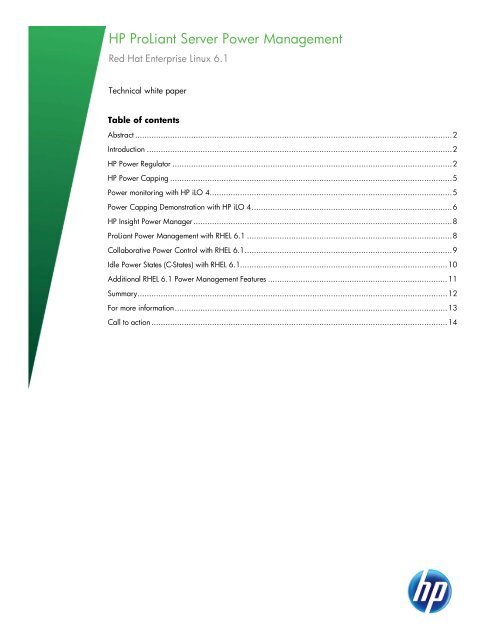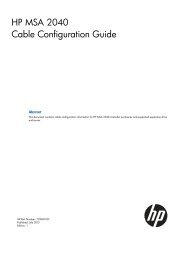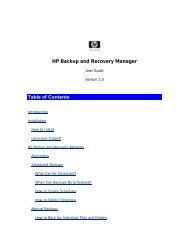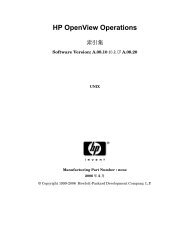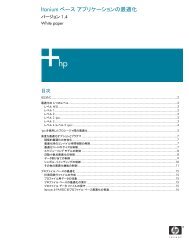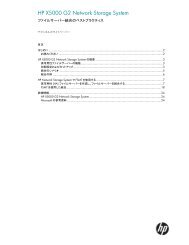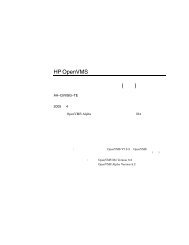HP ProLiant Server Power Management - Hewlett Packard
HP ProLiant Server Power Management - Hewlett Packard
HP ProLiant Server Power Management - Hewlett Packard
Create successful ePaper yourself
Turn your PDF publications into a flip-book with our unique Google optimized e-Paper software.
<strong>HP</strong> <strong>ProLiant</strong> <strong>Server</strong> <strong>Power</strong> <strong>Management</strong><br />
Red Hat Enterprise Linux 6.1<br />
Technical white paper<br />
Table of contents<br />
Abstract ........................................................................................................................................ 2<br />
Introduction ................................................................................................................................... 2<br />
<strong>HP</strong> <strong>Power</strong> Regulator ........................................................................................................................ 2<br />
<strong>HP</strong> <strong>Power</strong> Capping ......................................................................................................................... 5<br />
<strong>Power</strong> monitoring with <strong>HP</strong> iLO 4 ........................................................................................................ 5<br />
<strong>Power</strong> Capping Demonstration with <strong>HP</strong> iLO 4 ...................................................................................... 6<br />
<strong>HP</strong> Insight <strong>Power</strong> Manager ............................................................................................................... 8<br />
<strong>ProLiant</strong> <strong>Power</strong> <strong>Management</strong> with RHEL 6.1 ........................................................................................ 8<br />
Collaborative <strong>Power</strong> Control with RHEL 6.1 ......................................................................................... 9<br />
Idle <strong>Power</strong> States (C-States) with RHEL 6.1......................................................................................... 10<br />
Additional RHEL 6.1 <strong>Power</strong> <strong>Management</strong> Features ............................................................................. 11<br />
Summary ..................................................................................................................................... 12<br />
For more information ..................................................................................................................... 13<br />
Call to action ............................................................................................................................... 14
2<br />
Abstract<br />
<strong>Power</strong> management is crucial to data center power provisioning. This document provides a brief<br />
overview of the processor-based power saving features supported on <strong>HP</strong> <strong>ProLiant</strong> servers and the<br />
power management features such as <strong>Power</strong> Regulator, <strong>Power</strong> Capping and Collaborative <strong>Power</strong><br />
Control that are embedded in the <strong>ProLiant</strong> platforms. This document also discusses how these features<br />
are used and their relationship to the Red Hat Enterprise Linux (RHEL) 6.1 operating system, including<br />
new features available with <strong>ProLiant</strong> Gen8 Intel-based servers and RHEL 6.1.<br />
Introduction<br />
The RHEL 6.1 operating system and the <strong>HP</strong> <strong>ProLiant</strong> servers together use processor-based features to<br />
achieve better power efficiency for processors. The processor-based features include:<br />
• Performance states (P-states) define a set of fixed operating frequencies and voltages, where P0<br />
represents the highest operating frequency and voltage. You can save power by entering P-states<br />
with lower frequency and voltage levels. Either the platform firmware or the operating system<br />
controls the P-states.<br />
• <strong>Power</strong> states (C-states), excluding the C0 state, represent idle states and determine the power<br />
consumed when a processor is idle. C0 is a non-idle state with higher C-states representing idle<br />
conditions with increasing power savings. The operating system controls the C-states.<br />
• Throttle states (T-states) define a set of fixed frequency percentages which can be used to regulate<br />
the power consumption and the thermal properties of the processor. <strong>ProLiant</strong> systems may reserve<br />
the use of T-states for the system firmware.<br />
In addition, <strong>ProLiant</strong> servers are also capable of utilizing the various processor states to support<br />
innovative power management features that are operating system independent and are implemented<br />
in the hardware and firmware:<br />
• <strong>HP</strong> <strong>Power</strong> Regulator provides a facility to efficiently control processor power usage and<br />
performance, either statically or dynamically depending on the mode selected.<br />
• <strong>HP</strong> <strong>Power</strong> Capping allows an administrator to limit the power consumed by a server.<br />
• <strong>HP</strong> Dynamic <strong>Power</strong> Capping has the additional feature of ensuring that the power limit set by an<br />
administrator is maintained by reacting to a spike in server workload more rapidly than basic <strong>HP</strong><br />
<strong>Power</strong> Capping.<br />
The <strong>Power</strong> Regulator and <strong>Power</strong> Capping technologies are designed to work in conjunction with each<br />
other. To make the operating system aware of <strong>Power</strong> Capping, <strong>HP</strong> provides the Collaborative <strong>Power</strong><br />
Control technology. This is a two-way communication mechanism established between the operating<br />
system and platform firmware, and can be used by the operating system and hardware<br />
collaboratively to choose the appropriate performance level for the server. Support for this technology<br />
is present in both RHEL 6.1 and on <strong>ProLiant</strong> Gen8 servers.<br />
<strong>HP</strong> <strong>Power</strong> Regulator<br />
<strong>HP</strong> <strong>Power</strong> Regulator is a configurable processor power usage feature which allows you to choose<br />
from several options for the server to manage P-states or to delegate control of regulating P-states to<br />
the operating system.
<strong>HP</strong> <strong>Power</strong> Regulator is implemented within the firmware on both Intel-based and AMD-based <strong>ProLiant</strong><br />
servers. 1<br />
<strong>ProLiant</strong> servers provide the following <strong>HP</strong> <strong>Power</strong> Regulator modes, that you can select from<br />
the ROM Based Setup Utility (RBSU) or through <strong>HP</strong> iLO 4:<br />
<strong>HP</strong> Dynamic<br />
The firmware is capable of managing the P-states. However, when the<br />
Collaborative <strong>Power</strong> Control (CPC) setting is enabled in RBSU, the OS and the<br />
firmware collaborate to attain the desired frequency for a processor. When CPC<br />
is disabled, this mode allows the firmware to exclusively control the P-states of a<br />
processor to match the server load. On <strong>HP</strong> <strong>ProLiant</strong> Gen8 servers, <strong>HP</strong> Dynamic is<br />
the default mode with the CPC setting enabled.<br />
<strong>HP</strong> Static Low The firmware controls the P-states. The P-state of the processor is static and it is set<br />
to the P-state which corresponds to the lowest operating frequency supported by<br />
the processor.<br />
<strong>HP</strong> Static High The firmware controls the P-states. The P-state of the processor is static and it is set<br />
to P0 which corresponds to the highest operating frequency supported by the<br />
processor.<br />
OS Control The RHEL 6.1 operating system controls the P-states and it manages the<br />
P-states according to the policy set by the administrator via the OS.<br />
For the <strong>HP</strong> Static Low and <strong>HP</strong> Static High modes above, you are advised to disable CPC to ensure<br />
that the firmware has exclusive control of the P-states. CPC is located within the Advanced <strong>Power</strong><br />
<strong>Management</strong> Options in RBSU. This causes RHEL 6.1 to report in the /var/log/messages file and<br />
in the dmesg output that CPU frequency scaling is not utilized on the server.<br />
The OS Control mode allows the <strong>ProLiant</strong> platform firmware to delegate the duty of managing P-states<br />
to the RHEL 6.1 operating system.<br />
You can adjust the <strong>Power</strong> Regulator Settings through the RBSU or the <strong>HP</strong> iLO 4 interface as shown in<br />
Figure 1. You must reboot the system to change the transitions to and from the OS Control mode but<br />
you can change the system between the other three modes dynamically.<br />
1<br />
For detailed information on <strong>HP</strong> <strong>Power</strong> Regulator support across the different generations of <strong>ProLiant</strong> platforms, see:<br />
http://h18013.www1.hp.com/products/servers/management/ilo/sup_servers.html<br />
3
4<br />
Figure 1: Configuring <strong>Power</strong> Regulator and <strong>Power</strong> Capping settings via iLO4<br />
To adjust the CPC setting, you have to access RBSU as shown in Figure 2. Modifying this setting<br />
requires a system reboot to take effect.<br />
Figure 2: Configuring the Collaborative <strong>Power</strong> Control (CPC) setting via RBSU<br />
For more information on <strong>HP</strong> <strong>Power</strong> Regulator technology, see:<br />
http://h20000.www2.hp.com/bc/docs/support/SupportManual/c00300430/c00300430.pdf
<strong>HP</strong> <strong>Power</strong> Capping<br />
<strong>Power</strong> Capping satisfies data center power provisioning requirements by allowing the data center<br />
administrator to provide a power budget to a single-server or a group of servers. The <strong>ProLiant</strong><br />
platform enforces that limit by changing the processor P-states and T-states in an operating system<br />
independent manner. <strong>Power</strong> Capping is independent of the <strong>HP</strong> <strong>Power</strong> Regulator setting and can<br />
occur in any setting. When server power is being capped under OS Control mode, the firmware<br />
overrides the power management instructions from the operating system for the duration of the<br />
capping.<br />
As shown in Figure 1, you can use <strong>HP</strong> iLO 4 to configure a power cap. <strong>HP</strong> iLO displays important<br />
information about maximum available power for the power supply, the peak observed power, and<br />
the minimum observed power for the server. With this information, you can select an appropriate<br />
power cap, either by specifying the absolute maximum watts or a percentage of the maximum<br />
observed power of the server.<br />
For more information on <strong>Power</strong> Capping, see:<br />
http://www.hp.com/go/dpc<br />
For an in-depth presentation on the <strong>Power</strong> Capping technology, see:<br />
http://h20000.www2.hp.com/bc/docs/support/SupportManual/c01549455/c01549455.pdf<br />
<strong>Power</strong> monitoring with <strong>HP</strong> iLO 4<br />
<strong>HP</strong> iLO 4 supports the facility to monitor current power consumption along historical timelines. As<br />
shown in Figure 3, <strong>HP</strong> iLO 4 displays the current power consumption as well as the peak and<br />
average power consumption for the past 24-hour and 20-minute time periods.<br />
5
6<br />
Figure 3: <strong>HP</strong> iLO 4 power meter readings for 24-hour and 20-minute time periods<br />
For more information on the <strong>HP</strong> Integrated Lights-Out (iLO) management technology, see:<br />
www.hp.com/go/iLO<br />
<strong>Power</strong> Capping Demonstration with <strong>HP</strong> iLO 4<br />
This section demonstrates the <strong>HP</strong> <strong>Power</strong> Capping functionality by increasing workload on a <strong>ProLiant</strong><br />
server under the RHEL 6.1 operating system. Figure 4 displays the iLO configuration setting for a<br />
server where the capping threshold is set to 180 watts. This means the maximum power consumption<br />
will be limited at approximately 180 watts. Figure 5 shows that when power capping is not set, the<br />
power consumption of a server increases when there is an increase in workload. You can also see<br />
that the maximum power was 227 watts while the minimum power was 209 watts in the past 5<br />
minutes. The average power was 213 watts. Figure 6 demonstrates that when capping is enabled,<br />
the platform limits the power consumption to 180 watts even with an increase in workload in order to<br />
satisfy the power budget set by the user.
Figure 4: <strong>HP</strong> <strong>Power</strong> Capping threshold configuration<br />
Figure 5: <strong>Power</strong> consumption without capping<br />
7
8<br />
Figure 6: <strong>Power</strong> consumption with capping<br />
<strong>HP</strong> Insight <strong>Power</strong> Manager<br />
<strong>HP</strong> Insight <strong>Power</strong> Manager (IPM) is an integrated power monitoring and management application that<br />
provides centralized control of server power consumption and thermal output at the data center level.<br />
With IPM, users can change the power cap settings on groups of servers at a time. IPM is a plug-in<br />
for the <strong>HP</strong> Systems Insight Manager (SIM) that monitors and controls <strong>HP</strong> <strong>ProLiant</strong> and <strong>HP</strong> Integrity<br />
servers throughout the data center.<br />
For more information on IPM, see:<br />
http://h18000.www1.hp.com/products/servers/management/ipm/index.html<br />
For more information on SIM, see:<br />
www.hp.com/go/sim<br />
<strong>ProLiant</strong> <strong>Power</strong> <strong>Management</strong> with RHEL 6.1<br />
RHEL 6.1 manages the power usage of <strong>ProLiant</strong> servers by adjusting the processor P-states when the<br />
<strong>HP</strong> <strong>Power</strong> Regulator setting in RBSU is configured in OS Control mode. Typically within the Linux<br />
operating system, a governor dictates the policy, while the actual P-state transition is accomplished by<br />
a suitable P-state driver. RHEL 6.1 offers a choice of governors, each implementing a different policy<br />
ranging from userspace, which enables the user space program (cpuspeed) to directly configure the<br />
processor frequency, to performance, which selects the P-state corresponding to the highest supported<br />
frequency. The default governor is the ondemand governor, which dynamically adjusts the processor<br />
P-states to match the load on the server.<br />
On Intel-based <strong>ProLiant</strong> platforms RHEL 6.1 natively supports the Intel Demand Based Switching with<br />
Enhanced Intel SpeedStep ® Technology. On AMD-based <strong>ProLiant</strong> platforms, RHEL 6.1 supports
AMD's <strong>Power</strong>Now! technology. The following table lists the P-state driver on Intel-based and<br />
AMD-based <strong>ProLiant</strong> G6, G7 or later platforms under OS Control mode.<br />
Processor Family P-state driver<br />
Intel ® Xeon ®<br />
acpi-cpufreq<br />
AMD Opteron <br />
powernow-k8<br />
In order for RHEL 6.1 to manage the power consumption of the processor, the firmware must<br />
communicate information about the processor P-states and their associated frequencies to the OS.<br />
You can find this information in the file and directories under /sys/devices/system/cpu.<br />
Included in the RHEL 6.1 media is the cpufreq-util command (installed via the cpufrequtils-<br />
007-5.el6.i686.rpm package) that provides information about the P-states of the processors in<br />
the system in a user-friendly format. When used without arguments, cpufreq-info displays<br />
information about all processor cores, including the P-state driver, the frequency range supported by<br />
the processor, the available frequency steps (which are the P-states), the available and current<br />
governors, and the current frequency. Example 1 shows how cpufreq-info also supports options<br />
to display information specific to a CPU.<br />
Example 1 Output for CPU 0 in OS Control mode<br />
# cpufreq-info -c 0<br />
cpufrequtils 007: cpufreq-info (C) Dominik Brodowski 2004-2009<br />
Report errors and bugs to cpufreq@vger.kernel.org, please.<br />
analyzing CPU 0:<br />
driver: acpi-cpufreq<br />
CPUs which run at the same hardware frequency: 0<br />
CPUs which need to have their frequency coordinated by software: 0<br />
maximum transition latency: 10.0 us.<br />
hardware limits: 1.20 GHz - 2.00 GHz<br />
available frequency steps: 2.00 GHz, 2.00 GHz, 1.90 GHz, 1.80 GHz,<br />
1.70 GHz, 1.60 GHz, 1.50 GHz, 1.40 GHz, 1.30 GHz, 1.20 GHz<br />
available cpufreq governors: ondemand, userspace, performance<br />
current policy: frequency should be within 1.20 GHz and 2.00 GHz.<br />
The governor "ondemand" may decide which speed to use<br />
within this range.<br />
current CPU frequency is 1.20 GHz.<br />
You can dynamically change the governor used under the OS Control mode by modifying the value<br />
in the /sys/devices/system/cpu/cpu*/cpufreq/scaling_governor file for each CPU.<br />
RHEL 6.1 provides the cpufreq-set command to select the governor. For more information about<br />
the cpufreq-util and cpufreq-set commands, refer to the RHEL 6.1 man pages.<br />
Collaborative <strong>Power</strong> Control with RHEL 6.1<br />
When <strong>ProLiant</strong> servers are under OS Control mode for power management, power capping may still<br />
be imposed by the platform without the knowledge of the operating system. First introduced on Intelbased<br />
G6 <strong>ProLiant</strong> servers and included in all Gen8 <strong>ProLiant</strong> servers is the ability for the server and<br />
the OS to collaborate on power management. <strong>HP</strong> provides the Collaborative <strong>Power</strong> Control (CPC)<br />
mechanism which is capable of providing capping related feedback to the operating system, as well<br />
as collaborating with the operating system in managing the power consumption of a server. This<br />
combination provides the quick response time of <strong>HP</strong> Dynamic <strong>Power</strong> Savings and still provides correct<br />
processor power information to the operating system.<br />
9
10<br />
CPC utilizes the Processor Clocking Control (PCC) interface which is an interface for coordinating<br />
processor performance between the platform firmware and the operating system. The PCC interface,<br />
jointly developed by <strong>HP</strong> and Microsoft is publicly available, allowing other platform vendors the<br />
option of implementing it.<br />
For more information on PCC, see:<br />
http://www.acpica.org/download/Processor-Clocking-Control-v1p0.pdf<br />
Platform firmware releases for Intel-based <strong>ProLiant</strong> G6 servers from August 2009 and later include<br />
support for CPC.<br />
When a CPC-enabled server is configured in <strong>HP</strong> Dynamic mode, the firmware does not present P-state<br />
information to the operating system. Instead, the firmware presents the minimum and maximum<br />
frequencies the processor supports, allowing the OS to pick any frequency within that range, rather<br />
than restricting the processor to specific P-states. As with OS Control mode, the operating system<br />
governor provides policy and requests through the new PCC driver (pcc-cpufreq) in RHEL 6.1 what<br />
performance is required from the processor. The platform firmware strives to honor the requested<br />
frequency. If the processor is capped at that time for any reason, then the platform firmware will<br />
inform the OS that the request could not be accomplished due to capping. When capping is not<br />
configured, the PCC driver still continues to function in lieu of the P-state driver. Example 2 shows a<br />
sample output for CPU 0 for a Gen8 server under RHEL 6.1.In this example, notice that the driver is<br />
pcc-cpufreq. Only the minimum and maximum frequency limits are displayed. Unlike under OS<br />
Control, there are no preset frequency steps.<br />
Example 2 Output for CPU 0 in <strong>HP</strong> Dynamic mode with CPC enabled<br />
# cpufreq-info -c 0<br />
cpufrequtils 007: cpufreq-info (C) Dominik Brodowski 2004-2009<br />
Report errors and bugs to cpufreq@vger.kernel.org, please.<br />
analyzing CPU 0:<br />
driver: pcc-cpufreq<br />
CPUs which run at the same hardware frequency: 0<br />
CPUs which need to have their frequency coordinated by software: 0<br />
maximum transition latency: 0.00 ms.<br />
hardware limits: 1.20 GHz - 2.00 GHz<br />
available cpufreq governors: ondemand, userspace, performance<br />
current policy: frequency should be within 1.20 GHz and 2.00 GHz.<br />
The governor "ondemand" may decide which speed to use<br />
within this range.<br />
current CPU frequency is 1.20 GHz.<br />
Idle <strong>Power</strong> States (C-States) with RHEL 6.1<br />
Processor power use at idle is a crucial factor in determining power consumption of a server when<br />
there is no workload to execute. Typically, when a processor does not have work to perform, the<br />
operating system places the processor in a halt state signified as C1. Newer generation processors<br />
support deep C-states, allowing RHEL 6.1 to take advantage of these states. Although C-states can<br />
significantly reduce power consumption, the drawback of going to a deeper C-state is the latency<br />
associated with the time it takes for the processor to wake up from its idle state and resume executing<br />
instructions. Information about the C-states for system processors is available in<br />
/sys/devices/system/cpu/cpu*/cpuidle/state*.
NOTE: You can configure the server to not utilize the idle C-states by choosing the No C-states<br />
setting in RBSU.<br />
Additional RHEL 6.1 <strong>Power</strong> <strong>Management</strong> Features<br />
RHEL 6.1 provides a comprehensive set of features for managing the power usage of <strong>ProLiant</strong> servers.<br />
The “Green IT” features introduced in RHEL6.0 2 and later offer the user a range of kernel and userspace<br />
features to manage server power consumption. With the “tickless when idle” kernel feature, it is<br />
possible to reduce the number of wakeups per seconds from 1024 to typically less than 30. For<br />
instance, in Figure 7, notice that the “Wakeups-from-idle per second” is below 23. Additional tools<br />
are available to monitor the system power consumption. For example, utilizing the powerTOP 3<br />
tool,<br />
you can identify processes that are most responsible for waking a processor up from its idle state and<br />
thereby driving up power consumption. Reference the powerTOP documentation for further reading<br />
on what the output of powerTOP represents, and for tips and tricks on how to best tune the server for<br />
maximum power savings.<br />
Figure 7 displays the powerTOP output on an idle 1P <strong>ProLiant</strong> DL360e Gen8 platform with Intel(R)<br />
Xeon(R) CPU E5-2420 processor and 2 GB system memory. The average residency in the deepest<br />
4<br />
supported C-state is about 49ms. This value is due to the processor being awakened about only 23<br />
per second times from its idle state. The output listing is for a case where the IPMI service has been<br />
stopped on the server 5<br />
.<br />
2 Red Hat Enterprise Linux 6: Green Computing Features<br />
3 An introduction to powerTOP: http://www.lesswatts.org/projects/powertop/powertop.php.<br />
4 ACPI C3 actually corresponds to hardware C6 state which is the deepest C-state supported by the processors on that platform<br />
5 Halting the IPMI driver results in a user losing the ability to remotely monitor the server. If the IPMI service is stopped in order to save power, it is<br />
possible to resume the IPMI service with the command service ipmi restart<br />
11
12<br />
Figure 7: <strong>Power</strong>TOP output on an idle <strong>ProLiant</strong> DL360e Gen8 with no IPMI service<br />
NOTE: You can see the P-states (frequencies) information in the powerTOP output only when the <strong>HP</strong><br />
<strong>Power</strong> Regulator is configured to OS Control mode.<br />
Summary<br />
<strong>HP</strong> <strong>ProLiant</strong> servers are enabled for saving power both when the server is under load and when the<br />
server is idle. The processor-based power management features when supported in the hardware are<br />
enabled by the firmware automatically, and are used in close co-ordination between the firmware<br />
and the RHEL 6.1 operating system. Typically, you do not have to activate these features. They are<br />
already enabled by default. Several innovative features such as the <strong>HP</strong> <strong>Power</strong> Regulator, <strong>HP</strong> <strong>Power</strong><br />
Capping, <strong>HP</strong> Dynamic <strong>Power</strong> Capping, and Collaborative <strong>Power</strong> Control provide advanced power<br />
saving and budgeting features on <strong>HP</strong> <strong>ProLiant</strong> servers.
For more information<br />
For additional information, refer to the resources listed below.<br />
Resource description Web address<br />
<strong>HP</strong> <strong>ProLiant</strong> Gen8 www.hp.com/go/proliantgen8<br />
<strong>HP</strong> Linux documentation<br />
www.hp.com/go/linux-docs, select <strong>HP</strong> Linux <strong>Server</strong><br />
<strong>Management</strong> Software.<br />
<strong>Power</strong> Regulator http://www.hp.com/servers/power-regulator<br />
<strong>Power</strong> Capping and <strong>HP</strong> Dynamic <strong>Power</strong><br />
Capping<br />
http://h20000.www2.hp.com/bc/docs/support/SupportManual/c<br />
01549455/c01549455.pdf<br />
<strong>Power</strong> Regulator for <strong>ProLiant</strong> servers http://h20000.www2.hp.com/bc/docs/support/SupportManual/c<br />
00300430/c00300430.pdf<br />
AMD <strong>Power</strong>Now! Technology http://www.amd.com/us/products/technologies/amd-powernowtechnology/Pages/amd-powernow-technology.aspx<br />
Enhanced Intel SpeedStep ® Technology<br />
and Demand Based Switching on Linux<br />
http://softwarecommunity.intel.com/articles/eng/1611.htm<br />
Linux cpufreq kernel documentation http://lxr.linux.no/linux+v2.6.32/Documentation/cpu-freq/<br />
Linux cpuidle kernel documentation http://lxr.linux.no/linux+v2.6.32/Documentation/cpuidle/<br />
Intelligent Platform <strong>Management</strong><br />
Interface (IPMI)<br />
http://www.intel.com/design/servers/ipmi/<br />
<strong>HP</strong> Integrated Lights-Out <strong>Management</strong><br />
Controller<br />
http://www.hp.com/go/ilo<br />
<strong>HP</strong> Insight <strong>Power</strong> Manager (IPM) http://www.hp.com/go/ipm<br />
<strong>HP</strong> System Insight Manager (SIM) http://www.hp.com/go/sim<br />
An introduction to powerTOP http://www.lesswatts.org/projects/powertop/powertop.php<br />
LessWatts http://www.lesswatts.org/<br />
Red Hat Enterprise Linux 6: Green<br />
Computing Features<br />
https://tw.redhat.com/about/news/archive/2010/5/red-hatexpands-green-computing-features-in-red-hat-enterprise-linux-6<br />
Linux on <strong>HP</strong> <strong>ProLiant</strong> servers http://www.hp.com/go/proliantlinux<br />
RHEL on <strong>HP</strong> servers http://h18004.www1.hp.com/products/servers/linux/redhat/rhel<br />
/index.html<br />
Processor Clocking Control (PCC)<br />
interface<br />
Kernel documentation on the Linux PCC<br />
implementation<br />
Introduction to PCC as presented at the<br />
Linux Foundation Collaboration Summit<br />
(LFCS) 2010<br />
http://www.acpica.org/download/Processor-Clocking-Controlv1p0.pdf <br />
http://lxr.linux.no/linux+v2.6.34/Documentation/cpu-freq/pcccpufreq.txt<br />
https://events.linuxfoundation.org/slides/lfcs2010_garbee.pdf
Call to action<br />
Send comments about this document to TechCom@<strong>HP</strong>.com<br />
© Copyright 2012 <strong>Hewlett</strong>-<strong>Packard</strong> Development Company, L.P. The information contained herein is subject to<br />
change without notice. The only warranties for <strong>HP</strong> products and services are set forth in the express warranty<br />
statements accompanying such products and services. Nothing herein should be construed as constituting an<br />
additional warranty. <strong>HP</strong> shall not be liable for technical or editorial errors or omissions contained herein.<br />
Microsoft, Windows, Windows NT, Windows XP, Windows Mobile, and Windows are U.S. registered<br />
trademarks of Microsoft Corporation.<br />
VMware ESX, ESXi and VMotion are U.S. registered trademarks of VMware, Inc.<br />
5900-2215, March 2012<br />
Share with colleagues


